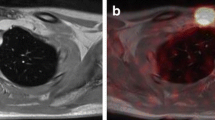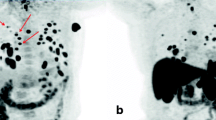Abstract
Purpose
To evaluate the diagnostic potential of PET/MRI with [18F]FDG in comparison to PET/CT in patients with differentiated thyroid cancer suspected or known to have dedifferentiated.
Methods
The study included 31 thyroidectomized and remnant-ablated patients who underwent a scheduled [18F]FDG PET/CT scan and were then enrolled for a PET/MRI scan of the neck and thorax. The datasets (PET/CT, PET/MRI) were rated regarding lesion count, conspicuity, diameter and characterization. Standardized uptake values were determined for all [18F]FDG-positive lesions. Histology, cytology, and examinations before and after treatment served as the standards of reference.
Results
Of 26 patients with a dedifferentiated tumour burden, 25 were correctly identified by both [18F]FDG PET/CT and PET/MRI. Detection rates by PET/CT and PET/MRI were 97 % (113 of 116 lesions) and 85 % (99 of 113 lesions) for malignant lesions, and 100 % (48 of 48 lesions) and 77 % (37 of 48 lesions) for benign lesions, respectively. Lesion conspicuity was higher on PET/CT for both malignant and benign pulmonary lesions and in the overall rating for malignant lesions (p < 0.001). There was a difference between PET/CT and PET/MRI in overall evaluation of malignant lesions (p < 0.01) and detection of pulmonary metastases (p < 0.001). Surgical evaluation revealed three malignant lesions missed by both modalities. PET/MRI additionally failed to detect 14 pulmonary metastases and 11 benign lesions.
Conclusion
In patients with thyroid cancer and suspected or known dedifferentiation, [18F]FDG PET/MRI was inferior to low-dose [18F]FDG PET/CT for the assessment of pulmonary status. However, for the assessment of cervical status, [18F]FDG PET/MRI was equal to contrast-enhanced neck [18F]FDG PET/CT. Therefore, [18F]FDG PET/MRI combined with a low-dose CT scan of the thorax may provide an imaging solution when high-quality imaging is needed and high-energy CT is undesirable or the use of a contrast agent is contraindicated.



Similar content being viewed by others
References
Maier TM, Schober O, Gerss J, Görlich D, Wenning C, Schaefers M, et al. Differentiated thyroid cancer patients more than 60 years old paradoxically show an increased life expectancy. J Nucl Med. 2015;56(2):190–5.
Verburg FA, Mader U, Tanase K, Thies ED, Diessl S, Buck AK, et al. Life expectancy is reduced in differentiated thyroid cancer patients ≥ 45 years old with extensive local tumor invasion, lateral lymph node, or distant metastases at diagnosis and normal in all other DTC patients. J Clin Endocrinol Metab. 2013;98(1):172–80.
Vrachimis A, Riemann B, Gerss J, Maier T, Schober O. Peace of mind for patients with differentiated thyroid cancer? Nuklearmedizin. 2013;52(4):115–20.
Vrachimis A, Wenning C, Gerss J, Dralle H, Vaez Tabassi M, Schober O, et al. Not all DTC patients with N positive disease deserve the attribution "high risk". contribution of the MSDS trial. J Surg Oncol. 2015;112(1):9–14.
Silberstein EB. The problem of the patient with thyroglobulin elevation but negative iodine scintigraphy: the TENIS syndrome. Semin Nucl Med. 2011;41(2):113–20.
Riemann B, Uhrhan K, Dietlein M, Schmidt D, Kuwert T, Dorn R, et al. Diagnostic value and therapeutic impact of (18)F-FDG-PET/CT in differentiated thyroid cancer. Results of a German multicentre study. Nuklearmedizin. 2013;52(1):1–6.
Khan N, Oriuchi N, Higuchi T, Zhang H, Endo K. PET in the follow-up of differentiated thyroid cancer. Br J Radiol. 2003;76(910):690–5.
Chandarana H, Heacock L, Rakheja R, DeMello LR, Bonavita J, Block TK, et al. Pulmonary nodules in patients with primary malignancy: comparison of hybrid PET/MR and PET/CT imaging. Radiology. 2013;268(3):874–81.
Beiderwellen K, Grueneisen J, Ruhlmann V, Buderath P, Aktas B, Heusch P, et al. (18)F]FDG PET/MRI vs. PET/CT for whole-body staging in patients with recurrent malignancies of the female pelvis: Initial results. Eur J Nucl Med Mol Imaging. 2015;42(1):56–65.
Kubiessa K, Purz S, Gawlitza M, Kühn A, Fuchs J, Steinhoff KG, et al. Initial clinical results of simultaneous 18F-FDG PET/MRI in comparison to 18F-FDG PET/CT in patients with head and neck cancer. Eur J Nucl Med Mol Imaging. 2014;41(4):639–48.
Platzek I, Beuthien-Baumann B, Schneider M, Gudziol V, Langner J, Schramm G, et al. PET/MRI in head and neck cancer: initial experience. Eur J Nucl Med Mol Imaging. 2013;40(1):6–11.
Queiroz MA, Hullner M, Kuhn F, Huber G, Meerwein C, Kollias S, et al. PET/MRI and PET/CT in follow-up of head and neck cancer patients. Eur J Nucl Med Mol Imaging. 2014;41(6):1066–75.
Schwenzer NF, Schraml C, Muller M, Brendle C, Sauter A, Spengler W, et al. Pulmonary lesion assessment: comparison of whole-body hybrid MR/PET and PET/CT imaging – pilot study. Radiology. 2012;264(2):551–8.
Lee KH, Park CM, Lee SM, Lee JM, Cho JY, Paeng JC, et al. Pulmonary nodule detection in patients with a primary malignancy using hybrid PET/MRI: is there value in adding contrast-enhanced MR imaging? PLoS One. 2015;10(6), e0129660.
American Thyroid Association (ATA) Guidelines Taskforce on Thyroid Nodules and Differentiated Thyroid Cancer, Cooper DS, Doherty GM, Haugen BR, Kloos RT, Lee SL, et al. Revised American Thyroid Association management guidelines for patients with thyroid nodules and differentiated thyroid cancer. Thyroid. 2009;19(11):1167–214.
Dietlein M, Dressler J, Eschner W, Grünwald F, Lassmann M, Leisner B, et al. Procedure guidelines for radioiodine therapy of differentiated thyroid cancer (version 3). Nuklearmedizin. 2007;46(5):213–9.
Luster M, Clarke SE, Dietlein M, Lassmann M, Lind P, Oyen WJ, et al. Guidelines for radioiodine therapy of differentiated thyroid cancer. Eur J Nucl Med Mol Imaging. 2008;35(10):1941–59.
Delso G, Furst S, Jakoby B, Ladebeck R, Ganter C, Nekolla SG, et al. Performance measurements of the Siemens mMR integrated whole-body PET/MR scanner. J Nucl Med. 2011;52(12):1914–22.
Kinahan PE, Townsend DW, Beyer T, Sashin D. Attenuation correction for a combined 3D PET/CT scanner. Med Phys. 1998;25(10):2046–53.
Martinez-Moller A, Souvatzoglou M, Delso G, Bundschuh RA, Chefd'hotel C, Ziegler SI, et al. Tissue classification as a potential approach for attenuation correction in whole-body PET/MRI: evaluation with PET/CT data. J Nucl Med. 2009;50(4):520–6.
Eisenhauer EA, Therasse P, Bogaerts J, Schwartz LH, Sargent D, Ford R, et al. New response evaluation criteria in solid tumours: revised RECIST guideline (version 1.1). Eur J Cancer. 2009;45(2):228–47.
Bland JM, Altman DG. Measuring agreement in method comparison studies. Stat Methods Med Res. 1999;8(2):135–60.
Brix G, Lechel U, Glatting G, Ziegler SI, Münzing W, Müller SP, et al. Radiation exposure of patients undergoing whole-body dual-modality 18F-FDG PET/CT examinations. J Nucl Med. 2005;46(4):608–13.
Cheng G, Alavi A, Lim E, Werner TJ, Del Bello CV, Akers SR. Dynamic changes of FDG uptake and clearance in normal tissues. Mol Imaging Biol. 2013;15(3):345–52.
Acknowledgements
We are grateful to the imaging staff of both our departments in particular Mrs. Anne Kanzog and Mr. Stan Milachowski. Furthermore, we are thankful to Mrs. Lale Umutlu (University Hospital Essen) for sharing her expertise in PET/MRI when asked.
Compliance with ethical standards
ᅟ
Conflict of interest
None.
Ethical approval
All procedures performed in studies involving human participants were in accordance with the ethical standards of the institutional and/or national research committee and with the principles of the 1964 Declaration of Helsinki and its later amendments or comparable ethical standards.
Informed consent
Informed consent was obtained from all individual participants included in the study.
Author information
Authors and Affiliations
Corresponding author
Electronic supplementary material
Below is the link to the electronic supplementary material.
Supplementary Table I
(XLSX 10 kb)
Supplementary Figure I
(JPEG 990 kb)
Supplementary Figure II
(JPEG 307 kb)
Rights and permissions
About this article
Cite this article
Vrachimis, A., Burg, M.C., Wenning, C. et al. [18F]FDG PET/CT outperforms [18F]FDG PET/MRI in differentiated thyroid cancer. Eur J Nucl Med Mol Imaging 43, 212–220 (2016). https://doi.org/10.1007/s00259-015-3195-2
Received:
Accepted:
Published:
Issue Date:
DOI: https://doi.org/10.1007/s00259-015-3195-2




